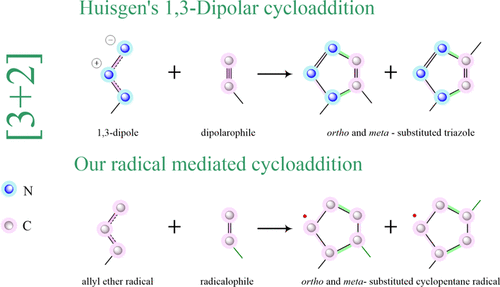Our official English website, www.x-mol.net, welcomes your
feedback! (Note: you will need to create a separate account there.)
Density Functional Theory Guide for an Allyl Monomer Polymerization Mechanism: Photoinduced Radical-Mediated [3 + 2] Cyclization
ACS Omega ( IF 3.7 ) Pub Date : 2021-06-08 , DOI: 10.1021/acsomega.1c00165 Xiaotian Zhao 1 , Wanqiu Huang 2 , Shibo Lin 1 , Xi Chen 1 , Xirui Guo 1 , Dehong Zou 1 , Guodong Ye 3
ACS Omega ( IF 3.7 ) Pub Date : 2021-06-08 , DOI: 10.1021/acsomega.1c00165 Xiaotian Zhao 1 , Wanqiu Huang 2 , Shibo Lin 1 , Xi Chen 1 , Xirui Guo 1 , Dehong Zou 1 , Guodong Ye 3
Affiliation

|
Polymerization of allyl ether monomers has previously been considered a free-radical addition polymerization mechanism, but it is difficult to achieve because of the high electron density of their double bond. To interpret the mechanism of photopolymerization, we therefore proposed a radical-mediated cyclization (RMC) reaction, which has been validated by results from quantum chemistry calculations and real-time infrared observation. Our RMC reaction begins with the radical abstracting one allylic hydrogen atom from the methylene group of allyl ether to generate an allyl ether radical with a delocalized π33 bond. Then, the radical reacts with the double bond of a second allyl ether molecule to form a five-membered cyclopentane-like ring (CP) radical. The CP radical abstracts a hydrogen atom from a third ether molecule. At last, a new allyl ether radical is generated and the next circulation as chain propagation begins. The distortion/interaction model was employed to explore the transient state of reaction, and real-time infrared was chosen to clarify the RMC reaction mechanism initiated by different photoinitiators. These results demonstrated that the RMC mechanism can give new insights into these fundamental processes.
中文翻译:

烯丙基单体聚合机制的密度泛函理论指南:光致自由基介导的 [3 + 2] 环化
烯丙基醚单体的聚合以前被认为是一种自由基加成聚合机制,但由于其双键的高电子密度而难以实现。因此,为了解释光聚合的机理,我们提出了自由基介导的环化 (RMC) 反应,该反应已通过量子化学计算和实时红外观察的结果进行验证。我们的 RMC 反应开始于自由基从烯丙基醚的亚甲基中夺取一个烯丙基氢原子以生成具有离域 π 3 3的烯丙基醚自由基键。然后,自由基与第二个烯丙基醚分子的双键反应形成五元环戊烷类环 (CP) 自由基。CP 自由基从第三个醚分子中提取一个氢原子。最后,新的烯丙基醚自由基产生,链增长开始下一个循环。采用畸变/相互作用模型来探索反应的瞬态,并选择实时红外来阐明不同光引发剂引发的RMC反应机理。这些结果表明 RMC 机制可以为这些基本过程提供新的见解。
更新日期:2021-06-22
中文翻译:

烯丙基单体聚合机制的密度泛函理论指南:光致自由基介导的 [3 + 2] 环化
烯丙基醚单体的聚合以前被认为是一种自由基加成聚合机制,但由于其双键的高电子密度而难以实现。因此,为了解释光聚合的机理,我们提出了自由基介导的环化 (RMC) 反应,该反应已通过量子化学计算和实时红外观察的结果进行验证。我们的 RMC 反应开始于自由基从烯丙基醚的亚甲基中夺取一个烯丙基氢原子以生成具有离域 π 3 3的烯丙基醚自由基键。然后,自由基与第二个烯丙基醚分子的双键反应形成五元环戊烷类环 (CP) 自由基。CP 自由基从第三个醚分子中提取一个氢原子。最后,新的烯丙基醚自由基产生,链增长开始下一个循环。采用畸变/相互作用模型来探索反应的瞬态,并选择实时红外来阐明不同光引发剂引发的RMC反应机理。这些结果表明 RMC 机制可以为这些基本过程提供新的见解。































 京公网安备 11010802027423号
京公网安备 11010802027423号